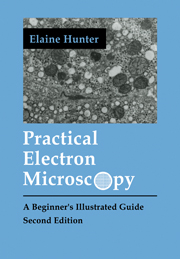Chapter 7 - Photography
Published online by Cambridge University Press: 05 June 2012
Summary
INTRODUCTION
After material has been prepared for viewing with the electron microscope, the most important step is to make a permanent photographic record of the findings. There are two main reasons for this: (1) the graininess of the phosphorescent viewing screen limits resolution, and (2) observation time is short due to progressive specimen contamination by the electron beam. Other reasons are (1) details not observed by the microscopist are often seen on a print, (2) two areas of a specimen cannot be compared on the EM screen, (3) it is very difficult to relocate a specific area on a grid, (4) photographs are essential for publication and/or to substantiate findings (sometimes a second opinion is required), and (5) a microscopist might want to make comparisons with previously published findings. A common mistake of beginners is to spend too long viewing the specimen. It is far more productive to take many pictures that can be examined carefully later; photographic film captures more detail than the microscope screen and is relatively inexpensive.
Proper control of exposure conditions is very important if one is to produce good-quality electron micrographs. One must follow the operator's manual for basic operations of camera, shutter mechanism, and metering system. There are, however, some general guidelines to follow in order to avoid common problems such as uneven illumination, blurred images due to specimen drift or astigmatism, damage to the specimen from the electron beam, and low-contrast negatives.
Information
- Type
- Chapter
- Information
- Practical Electron MicroscopyA Beginner's Illustrated Guide, pp. 135 - 156Publisher: Cambridge University PressPrint publication year: 1993
